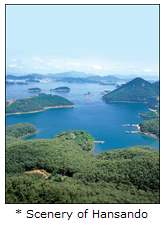8. The battle of Hansando (June 8, 1592)
Although, Toyotomi Hideyoshi ordered their navy to be united and attack Joseon navy together, Wakisaka Yasuharu decided to defeat Yi’s fleet by himself. On July 7, his fleet was departed from the Japanese headquarter in Jinhae. When Wakisaka’s fleet arrived near by Geojedo island, his fleet anchored off Gyeonnaeryang. On the other hand, a shepherd reported that Japanese fleet was anchoring at Gyeonnaeryang to Joseon fleet. Joseon fleet decided to entice Japanese fleet from there to the open sea, because that sea is shallow and it was hard to change body of main warship, Panokseon. Furthermore, Japanese tended to abandon ships and retreat to the island if they reach an impasse in the middle of battle.
 On July 8, 5~6 ships went to Gyeonnaeryang while remaining ships were poised to attack off Hansando island. Joseon squadron enticed Japanese and poised to retreat from there, Japanese followed them. Squadron arrived at the open sea and joined Joseon fleet. Admiral Yi ordered to make his famous tactic, Hakikjin, crane wing formation. Joseon warships discharged guns and 2~3 Japanese warships in front line were sunken by this attack. Joseon fleet attacked flagship first and surrounded them. Wakisaka drove 14 ships and retreated.
On July 8, 5~6 ships went to Gyeonnaeryang while remaining ships were poised to attack off Hansando island. Joseon squadron enticed Japanese and poised to retreat from there, Japanese followed them. Squadron arrived at the open sea and joined Joseon fleet. Admiral Yi ordered to make his famous tactic, Hakikjin, crane wing formation. Joseon warships discharged guns and 2~3 Japanese warships in front line were sunken by this attack. Joseon fleet attacked flagship first and surrounded them. Wakisaka drove 14 ships and retreated.
| Joseon fleet | Japanese fleet | |
|---|---|---|
| Commander | Admiral Yi sun-shin, Yi eok-gi, Won gyun | Wakisaka Yasuharu |
| Strength | 59 panokships and 50 small vessels | 73 ships |
| Casualties and losses | None | 59 ships destroyed |
Although, Toyotomi Hideyoshi ordered their navy to be united and attack Joseon navy together, Wakisaka Yasuharu decided to defeat Yi’s fleet by himself. On July 7, his fleet was departed from the Japanese headquarter in Jinhae. When Wakisaka’s fleet arrived near by Geojedo island, his fleet anchored off Gyeonnaeryang. On the other hand, a shepherd reported that Japanese fleet was anchoring at Gyeonnaeryang to Joseon fleet. Joseon fleet decided to entice Japanese fleet from there to the open sea, because that sea is shallow and it was hard to change body of main warship, Panokseon. Furthermore, Japanese tended to abandon ships and retreat to the island if they reach an impasse in the middle of battle.
 On July 8, 5~6 ships went to Gyeonnaeryang while remaining ships were poised to attack off Hansando island. Joseon squadron enticed Japanese and poised to retreat from there, Japanese followed them. Squadron arrived at the open sea and joined Joseon fleet. Admiral Yi ordered to make his famous tactic, Hakikjin, crane wing formation. Joseon warships discharged guns and 2~3 Japanese warships in front line were sunken by this attack. Joseon fleet attacked flagship first and surrounded them. Wakisaka drove 14 ships and retreated.
On July 8, 5~6 ships went to Gyeonnaeryang while remaining ships were poised to attack off Hansando island. Joseon squadron enticed Japanese and poised to retreat from there, Japanese followed them. Squadron arrived at the open sea and joined Joseon fleet. Admiral Yi ordered to make his famous tactic, Hakikjin, crane wing formation. Joseon warships discharged guns and 2~3 Japanese warships in front line were sunken by this attack. Joseon fleet attacked flagship first and surrounded them. Wakisaka drove 14 ships and retreated.